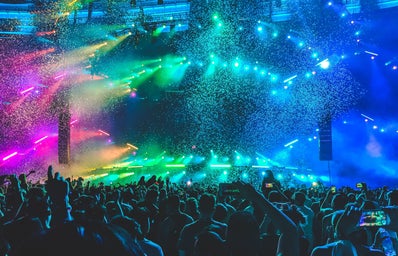I’ve been listening to the Six soundtrack all morning in preparation for writing this article and let me tell you, there’s been an extra spring in my step.
If you haven’t heard of it, Six is a musical that imagines the wives of Henry VIII as a spectacular, unapologetically feminine girl group. It’s taking the United Kingdom by storm and is spreading slowly but surely across the United States. Before the Chicago cast makes its Broadway transfer in February, let’s all get hooked together.
We have a historical reenactment that seeks to rewrite well-known history with the focus on seemingly minor characters, with the attempt of revisionism in favor of a marginalized group. I’m aware that sounds suspiciously similar to Hamilton, especially with the influx of modern music and the frequent fourth-wall-breaking. Before I listened to it, I thought so too.
But in my opinion — and the critics will probably disagree — it’s better.
Yes, “The Schuyler Sisters” does slap, but that’s the one song that women have within Hamilton. After that, women are relegated to romantic interests, albeit strong ones, and that’s about it. It’s still a powerful, groundbreaking musical! But I have to say, I got a little shifty after a couple years of listening. I think making room for people of color in history is a wonderful sentiment, but where is the space for powerful women in their own right, unrelated to their husbands or romantic prospects? Especially for women of color, who have the double-whammy of structural discrimination against them?
Then came Six, replying to that exact historical conundrum. Wives notoriously characterized and attached to their abuser, Henry VIII, are represented in their own rights within their own musical. Even the members of the band are entirely women, as is the playwright. Henry VIII is not shown on stage one time! Because it’s not his show. It’s for the girls.
The soundtrack sings praise upon praise to female songstresses. Catherine Parr and Anna of Cleves have clear links to Beyonce, even through their lyrics (“I’m a survivor,” and “Okay, ladies, let’s get in reformation,”), and Anne Boleyn has an Avril Lavigne twang. Katherine Howard, with a style somewhere between Iggy Azalea and Demi Lovato, is particularly dynamic, in my opinion. While her song is playful and sexy, upon further listening, the darker undertones grow more and more apparent. This is the narrative of a woman who has been groomed and sexually abused from a very young age, and it ends up ruining her life. Six returns power to the hands of women who have been beheaded, abandoned, divorced and relegated to the backseat of a cruel husband.
The music, as I discussed before, is incredibly diverse in its sounds and representations. Women of all sizes, colors and ages are encouraged to play any of the parts. The narrative structure of a concert with a full band onstage was introduced in Bloody Bloody Andrew Jackson, another favorite musical of mine, but it is also one that sings an unabashedly male-dominated narrative. Moreover, there was still plot-building separate from the concert style. Six is full-concert, full-blast. Broadway hasn’t seen anything like it.
It’s witty and so much fun — if you’re active on TikTok, you’ll probably recognize some of the soundbites, as multiple clips went viral through memes without the acknowledgement of their origin. It’s ridiculously catchy.
At the very end of the musical is a fun remix of all the songs except for the notoriously absurd “Haus of Holbein”. It’s not included on the cast album, but the actresses encourage fans to get out their phones and record “Megamix”– a stark contrast to Lin-Manuel Miranda’s long Twitter rants in regard to bootleggers, and a step in the right direction to class inclusion and theater accessibility. You can find uploads upon uploads of “Megamix” on Youtube, and you should check it out if you’re thinking of plunging into the soundtrack. The power of femininity is so blatantly represented in the three and a half minutes we’re given, and, better yet, you can hear the power of the mostly-female audience too. The cast encourages those watching to sing along, and they certainly do. It makes my heart so happy to have such a massive energy produced by young girls singing together in a theater, watching a West End performance.
Western Theatre is still a big white boys’ game, despite the leaps and bounds that have been made in the past in favor of women and people of color. In the crowd for Six, however, voices of girls and women raise together in harmony, as they watch women of all colors, shapes and creeds bedecked in royal garb, each a queen in her own right. That means more to me than any stuffy theater critique.


